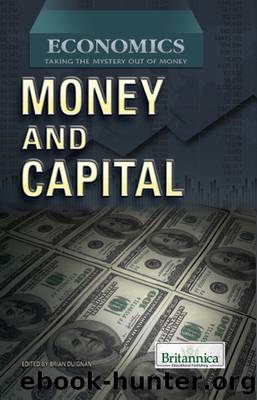Money and Capital by Britannica Educational Publishing

Author:Britannica Educational Publishing
Language: eng
Format: epub
Publisher: Britannica Educational Publishing
Published: 2013-01-15T00:00:00+00:00
Chinese 100-yuan banknote (obverse). Courtesy of Frank Feng
Chinese 100-yuan banknote (reverse). Courtesy of Frank Feng
BITCOIN
Bitcoin is a digital currency created by an anonymous computer programmer or group of programmers known as Satoshi Nakamoto in 2009. Owners of Bitcoins can use various Web sites to trade them for physical currencies, such as U.S. dollars or euros, or can exchange them for goods and services from a number of vendors.
Nakamoto was concerned that traditional currencies were too reliant on the trustworthiness of banks to work properly. Nakamoto proposed a digital currency, Bitcoin, that could serve as a medium of exchange without relying on any financial institutions or governments.
Bitcoin relies on public-key cryptography, in which users have a public key that is available for everyone to see and a private key known only to their computers. In a Bitcoin transaction, users receiving Bitcoins send their public keys to users transferring the Bitcoins. Users transferring the coins sign with their private keys, and the transaction is then transmitted over the Bitcoin network. The time of each transaction is recorded so no Bitcoin can be spent more than once at the same time.
New Bitcoins are created by users running the Bitcoin client on their computers. The client âminesâ Bitcoins by running a program that solves a difficult mathematical problem in a file called a âblockâ received by all users on the Bitcoin network. The difficulty of the problem is adjusted so that, no matter how many people are mining Bitcoins, the problem is solved, on average, six times an hour. When a user solves the problem in a block, that user receives a certain number of Bitcoins. The elaborate procedure for mining Bitcoins ensures that their supply is restricted and grows at a steadily decreasing rate. About every four years, the number of Bitcoins in a block, which began at 50, will be halved. The number of maximum allowable Bitcoins is slightly less than 21 million. As of late 2011 there were 7.6 million Bitcoins, and it is estimated that the maximum number will be reached around 2140.
The value of Bitcoins relative to physical currencies fluctuated wildly in the years following its introduction. In August 2010 one Bitcoin was worth $0.05 (U.S.). Beginning in May 2011, the Bitcoin increased sharply in value, reaching a peak of about $30 that June, but by the end of the year the value of a Bitcoin had collapsed to less than $3.
Download
This site does not store any files on its server. We only index and link to content provided by other sites. Please contact the content providers to delete copyright contents if any and email us, we'll remove relevant links or contents immediately.
| Customs, Traditions, Anthropology | General |
| Sociology |
This Is How You Lose Her by Junot Diaz(6794)
The Kite Runner by Khaled Hosseini(5083)
The Mayflower and the Pilgrims' New World by Nathaniel Philbrick(4423)
Bloody Times by James L. Swanson(4314)
Pocahontas by Joseph Bruchac(4182)
Flesh and Blood So Cheap by Albert Marrin(3779)
An American Plague by Jim Murphy(3710)
The 101 Dalmatians by Dodie Smith(3453)
Hello, America by Livia Bitton-Jackson(3094)
Finding Gobi by Dion Leonard(2783)
Harry Potter and the Half-Blood Prince (hp-6) by J. K. Rowling(2453)
The Impossible Rescue by Martin W. Sandler(2278)
See You in the Cosmos by Jack Cheng(2158)
I Will Always Write Back by Martin Ganda(2106)
Bloody Times: The Funeral of Abraham Lincoln and the Manhunt for Jefferson Davis by James L. Swanson(2058)
When Dimple Met Rishi by Sandhya Menon(1980)
The Queen of Attolia by Megan Whalen Turner(1963)
The Crossover by Kwame Alexander(1897)
Hoodoo by Ronald L. Smith(1838)
